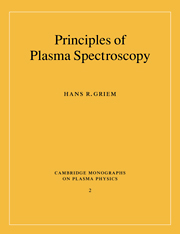Book contents
- Frontmatter
- Contents
- Preface
- Symbols
- 1 Classical theory of radiation
- 2 Quantum theory of radiation
- 3 Oscillator and line strengths
- 4 Spectral line broadening
- 5 Continuous spectra
- 6 Cross sections and level kinetics
- 7 Thermodynamic equilibrium relations
- 8 Radiative energy transfer
- 9 Radiation losses
- 10 Spectroscopic density measurements
- 11 Spectroscopic temperature measurements
- 12 Other diagnostic applications of plasma spectroscopy
- References
- Index
6 - Cross sections and level kinetics
Published online by Cambridge University Press: 29 August 2009
- Frontmatter
- Contents
- Preface
- Symbols
- 1 Classical theory of radiation
- 2 Quantum theory of radiation
- 3 Oscillator and line strengths
- 4 Spectral line broadening
- 5 Continuous spectra
- 6 Cross sections and level kinetics
- 7 Thermodynamic equilibrium relations
- 8 Radiative energy transfer
- 9 Radiation losses
- 10 Spectroscopic density measurements
- 11 Spectroscopic temperature measurements
- 12 Other diagnostic applications of plasma spectroscopy
- References
- Index
Summary
Observable intensities of spectral lines and continua depend just as strongly on the appropriate level populations as on the transition probabilities and related quantities discussed in chapters 2 and 3, and on the radiative transfer processes to be discussed in chapter 8. The level population and transfer problems are not really separable. One must therefore strive for internal consistency, following the example of astrophysicists (see, e.g., Mihalas 1978). Nevertheless, it is reasonable to discuss first the various population and depopulation processes as if these interconnections were not very important. Often only processes affecting discrete states that are not very close to the corresponding continuum limits need to be evaluated explicitly. This important simplification arises because the rates of collisional processes controlling the relative populations of highly excited states tend to be very large, thus facilitating the establishment of so-called partial local thermodynamic equilibrium (PLTE, see sections 7.1 and 7.6). However, the lower excited level populations often need explicit evaluation, especially because these levels tend to give rise to the strongest lines. Note also that electron collisional rates usually, but not always, dominate because of their high velocities and of their energy-dependent cross sections that are similar to those for ions.
- Type
- Chapter
- Information
- Principles of Plasma Spectroscopy , pp. 156 - 186Publisher: Cambridge University PressPrint publication year: 1997



